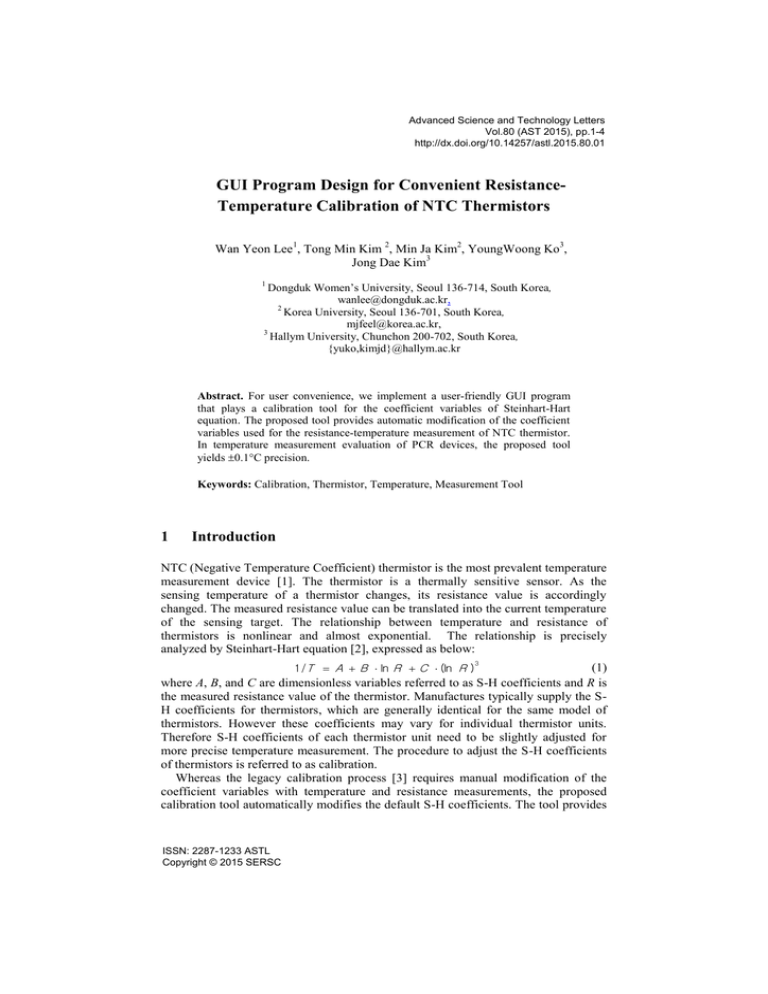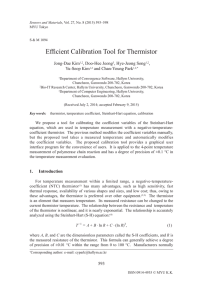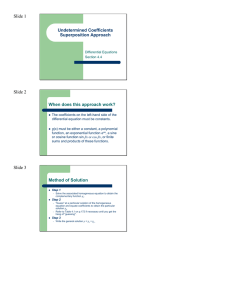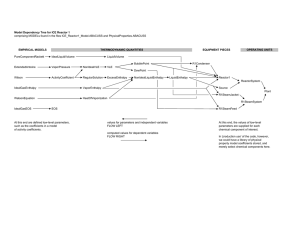GUI Program Design for Convenient Resistance
advertisement

Advanced Science and Technology Letters
Vol.80 (AST 2015), pp.1-4
http://dx.doi.org/10.14257/astl.2015.80.01
GUI Program Design for Convenient ResistanceTemperature Calibration of NTC Thermistors
Wan Yeon Lee1, Tong Min Kim 2, Min Ja Kim2, YoungWoong Ko3,
Jong Dae Kim3
1
Dongduk Women’s University, Seoul 136-714, South Korea,
wanlee@dongduk.ac.kr,
2
Korea University, Seoul 136-701, South Korea,
mjfeel@korea.ac.kr,
3
Hallym University, Chunchon 200-702, South Korea,
{yuko,kimjd}@hallym.ac.kr
Abstract. For user convenience, we implement a user-friendly GUI program
that plays a calibration tool for the coefficient variables of Steinhart-Hart
equation. The proposed tool provides automatic modification of the coefficient
variables used for the resistance-temperature measurement of NTC thermistor.
In temperature measurement evaluation of PCR devices, the proposed tool
yields 0.1C precision.
Keywords: Calibration, Thermistor, Temperature, Measurement Tool
1
Introduction
NTC (Negative Temperature Coefficient) thermistor is the most prevalent temperature
measurement device [1]. The thermistor is a thermally sensitive sensor. As the
sensing temperature of a thermistor changes, its resistance value is accordingly
changed. The measured resistance value can be translated into the current temperature
of the sensing target. The relationship between temperature and resistance of
thermistors is nonlinear and almost exponential. The relationship is precisely
analyzed by Steinhart-Hart equation [2], expressed as below:
3
(1)
where A, B, and C are dimensionless variables referred to as S-H coefficients and R is
the measured resistance value of the thermistor. Manufactures typically supply the SH coefficients for thermistors, which are generally identical for the same model of
thermistors. However these coefficients may vary for individual thermistor units.
Therefore S-H coefficients of each thermistor unit need to be slightly adjusted for
more precise temperature measurement. The procedure to adjust the S-H coefficients
of thermistors is referred to as calibration.
Whereas the legacy calibration process [3] requires manual modification of the
coefficient variables with temperature and resistance measurements, the proposed
calibration tool automatically modifies the default S-H coefficients. The tool provides
1 /T A B ln R C (ln R )
ISSN: 2287-1233 ASTL
Copyright © 2015 SERSC
Advanced Science and Technology Letters
Vol.80 (AST 2015)
greater user convenience by simply recording the difference between the measured
temperature and the reference temperature upon a user-friendly GUI(graphic user
interface) program. The tool yields 0.1C precision in 4-points temperature
measurements of PCR device.
2
Proposed User-friendly Calibration Tool
The default S-H coefficients before calibration are denoted as A, B and C. The
modified S-H coefficients after calibration are dented as A’, B’ and C’. The
measured temperature using the default coefficients is denoted as T. The known
reference temperature in thermally stable liquid bath [4] is denoted as T R. When
measuring the reference temperature of liquid bath, the measured temperature T
might be different from the exactly known reference temperature T R if the
default S-H coefficients are not exact. The proposed calibration tool makes
TT R by modifying the default S-H coefficients.
From the measured temperature T and the default S-H coefficients (A, B and
C), the tool first calculates the resistance value R of thermistors using the below
equation (2), which is the inverse equation of equation (1):
R exp(
3
3
) where A 1 /T and
2C
(
B
3C
3
)
2
(2)
Next, the tool derives the modified S-H coefficients A’, B’ and C’ by applying the
calculated resistance R and the reference temperature TR to equation (1). If three
resistance values (R1, R2, R3) are calculated under three known reference temperatures
(T1R, T2R, T3R) respectively, the three coefficient variables (A’, B’, C’) can be directly
derived by applying the three resistance values and the three known temperatures to
equation (1) and solving the three equations:
R
for i=1,2,3
The proposed tool provides a graphic user interface (GUI) such as shown in figure 1.
The GUI runs on Windows XP or Windows 7, and is implemented using Microsoft
Visual Studio 2008 and Microsoft Foundation Class (MFC). For easy calibration
handling and one step calibration process, the user records only the difference of the
measured temperature from the reference temperature (i.e., T – TR) upon GUI
program as an input parameter. Then the proposed tool calculates the measured
temperature T from the input parameter. Given the measured temperature T and the
default S-H coefficients, the tool derives the resistance value R using equation (2).
The tool obtains the modified S-H coefficients A’, B’ and C’ by applying the resistance
R and the reference temperature TR to equation (1).
1 /T i
2
A ' B ' ln R i C '(ln R i )
3
Copyright © 2015 SERSC
Advanced Science and Technology Letters
Vol.80 (AST 2015)
Fig. 1. GUI program
Finally the tool automatically substitutes the modified S-H coefficients for the default
S-H coefficients. Figure 2 shows the modified S-H coefficients values in the GUI
program of the proposed tool.
Fig. 2. Modified S-H coefficients in GUI program
3
Evaluation
The proposed tool is applied to PCR(Polymerase Chain Reaction) devices [5] using
four different temperatures such as 4C, 60C, 72C, and 95C. For the calibration of
each channel with four temperature points, we apply the least squares fitting method
Copyright © 2015 SERSC
3
Advanced Science and Technology Letters
Vol.80 (AST 2015)
that minimizes the sum of measurement errors. In the temperature measurements with
the default S-H coefficients, the maximum measurement error is 0.4C, and the
average measurement error is about 0.161C. In temperature measurements with the
modified S-H coefficients after calibration, the maximum measurement error is 0.1C,
and the average measurement error is about 0.037C. The proposed tool yields 0.1C
precision. Consequently, the proposed tool significantly enhances the temperature
measurement accuracy.
4
Conclusions
The proposed calibration tool automatically modifies the default S-H
coefficients given by thermistor manufactures. The proposed tool provides
greater user convenience by simply recording the difference between the
measured temperature and the reference temperature upon a user-friendly GUI
program. In the temperature measurement evaluation of PCR devices, the
proposed tool significantly enhances the temperature measurement accuracy
with a precision of 0.1C.
Acknowledgments. This research was supported by Basic Science Research
Program through the National Research Foundation of Korea (NRF) funded by the
Ministry of Education, Science and Technology (2011-0009358).
References
1. C. Chen, “Evaluation of Resistance–Temperature Calibration Equations for NTC
Thermistors,” Measurement, vol. 42, pp. 1103–1111, 2009.
2. J. Steinhart and S. Hart, “Calibration Curves for Thermistors”, Deep Sea Research and
Oceanographic Abstracts, vol. 15, no. 4, pp. 497-503, 1968.
3. M. Alexander and K. MacQuarrie, “Toward a Standard Thermistor Calibration Method: Data
Correction Spreadsheets”, Ground Water Monitoring & Remediation, vol. 25, no. 5, pp. 7581, 2005.
4. J.D. Kim, et al., “Calibration of Buffer-less System for Thermistor Temperature
Measurement,” International Conference on ICT Convergence, pp. 240-242, Oct. 2012.
5. T. A. Brown, Gene Cloning and DNA Analysis: An Introduction, 6th Ed., Wiley-Blackwell,
West Sussex, 2010.
4
Copyright © 2015 SERSC






